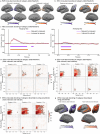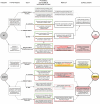Adversarial testing of global neuronal workspace and integrated information theories of consciousness
- PMID: 40307561
- PMCID: PMC12137136
- DOI: 10.1038/s41586-025-08888-1
Adversarial testing of global neuronal workspace and integrated information theories of consciousness
Abstract
Different theories explain how subjective experience arises from brain activity1,2. These theories have independently accrued evidence, but have not been directly compared3. Here we present an open science adversarial collaboration directly juxtaposing integrated information theory (IIT)4,5 and global neuronal workspace theory (GNWT)6-10 via a theory-neutral consortium11-13. The theory proponents and the consortium developed and preregistered the experimental design, divergent predictions, expected outcomes and interpretation thereof12. Human participants (n = 256) viewed suprathreshold stimuli for variable durations while neural activity was measured with functional magnetic resonance imaging, magnetoencephalography and intracranial electroencephalography. We found information about conscious content in visual, ventrotemporal and inferior frontal cortex, with sustained responses in occipital and lateral temporal cortex reflecting stimulus duration, and content-specific synchronization between frontal and early visual areas. These results align with some predictions of IIT and GNWT, while substantially challenging key tenets of both theories. For IIT, a lack of sustained synchronization within the posterior cortex contradicts the claim that network connectivity specifies consciousness. GNWT is challenged by the general lack of ignition at stimulus offset and limited representation of certain conscious dimensions in the prefrontal cortex. These challenges extend to other theories of consciousness that share some of the predictions tested here14-17. Beyond challenging the theories, we present an alternative approach to advance cognitive neuroscience through principled, theory-driven, collaborative research and highlight the need for a quantitative framework for systematic theory testing and building.
© 2025. The Author(s).
Conflict of interest statement
Competing interests: C. Koch and G.T. are a board members and have a financial interest in Intrinsic Powers, a company developing a clinical device for assessing the presence and absence of consciousness in patients. C. Koch is the Chief Scientist of the Tiny Blue Dot Foundation in Santa Monica, CA. G.T. holds a patent for a method of assessing anaesthetization (patent no.: US 8,457,731 B2). S.Dehaene is a co-inventor on patent 2019 EP 2983586 (‘Methods to monitor consciousness’); and is an associate at NeuroMeters, a company that applies these methods in clinical practice. None of these affiliations impose restrictions on publication or present conflicts of interest related to this study. The other authors declare no competing interests.
Figures











References
-
- Seth, A. K. & Bayne, T. Theories of consciousness. Nat. Rev. Neurosci.10.1038/s41583-022-00587-4 (2022). - PubMed
-
- Yaron, I., Melloni, L., Pitts, M. & Mudrik, L. The ConTraSt database for analysing and comparing empirical studies of consciousness theories. Nat. Hum. Behav.6, 593–604 (2022). - PubMed
-
- Tononi, G., Boly, M., Massimini, M. & Koch, C. Integrated information theory: from consciousness to its physical substrate. Nat. Rev. Neurosci.17, 450–461 (2016). - PubMed
MeSH terms
LinkOut - more resources
Full Text Sources

